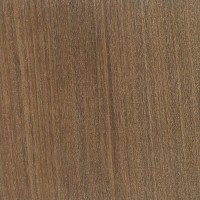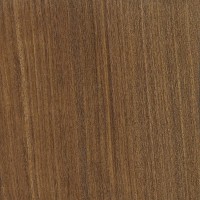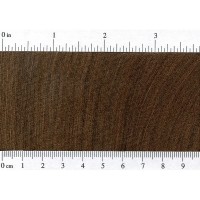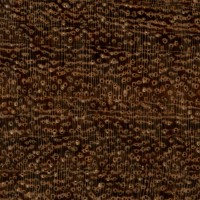 |
Common Name(s): Brown Ebony, Guayacan Scientific Name: Libidibia paraguariensis (=Caesalpinia paraguariensis) Distribution: Semi-arid regions of South America Tree Size: 30-50 ft (10-15 m) tall, 2-3 ft (.6-1.0 m) trunk diameter Average Dried Weight: 72 lbs/ft3 (1,160 kg/m3) Specific Gravity (Basic, 12% MC): .91, 1.16 Janka Hardness: 3,590 lbf (15,970 N) Modulus of Rupture: 22,910 lbf/in2 (158.0 MPa)* Elastic Modulus: 2,712,000 lbf/in2 (18.70 GPa)* Crushing Strength: 11,790 lbf/in2 (81.3 MPa)* *values from tentative strength group assessment per South American Timbers Shrinkage: Radial: 4.5%, Tangential: 7.7%, Volumetric: 12.7%, T/R Ratio: 1.7 |
Color/Appearance: Heartwood is a dark brown, sometimes with a reddish hue. Pale yellow sapwood is clearly demarcated from heartwood.
Grain/Texture: Grain is straight to irregular or interlocked. Uniform medium to coarse texture, with moderate natural luster.
Endgrain: Diffuse-porous; medium pores, few; solitary and radial multiples; reddish brown heartwood deposits abundant; parenchyma vasicentric, lozenge, winged, confluent, and banded; narrow rays, normal spacing.
Rot Resistance: Rated as very durable, though susceptible to insect attack.
Workability: Generally difficult to work on account of its high density and irregular grain. Brown Ebony is well suited to lathe work, and turns and finishes well.
Odor: No characteristic odor.
Allergies/Toxicity: Although severe reactions are quite uncommon, Brown Ebony has been reported to cause skin irritation. See the articles Wood Allergies and Toxicity and Wood Dust Safety for more information.
Pricing/Availability: Occasionally available for sale in the form of small blanks and turning squares. Prices are in the medium range for an imported lumber, and much lower than true ebonies.
Sustainability: This wood species is not listed in the CITES Appendices, but is on the IUCN Red List. It is listed as vulnerable due to a population reduction of over 20% in the past three generations, caused by a decline in its natural range, and exploitation.
Common Uses: Primarily for turned objects; also used for heavy construction within its natural range.
Comments: Being that the term “ebony” is synonymous with black, the term “Brown Ebony” may be somewhat of a oxymoron. Brown Ebony is not in the Diospyros genus, and isn’t considered a true ebony. Botanically, the wood is actually more closely related to Brazilwood—well known for its use in violin bows.







